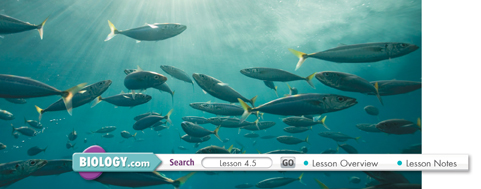4.5 Aquatic Ecosystems
 What factors affect life in aquatic ecosystems?
What factors affect life in aquatic ecosystems? What are the major categories of freshwater ecosystems?
What are the major categories of freshwater ecosystems? Why are estuaries so important?
Why are estuaries so important? How do ecologists usually classify marine ecosystems?
How do ecologists usually classify marine ecosystems?
photic zone • aphotic zone • benthos • plankton • wetland • estuary
Compare/Contrast Table As you read, note the similarities and differences between the major freshwater and marine ecosystems in a compare/contrast table.
THINK ABOUT IT We call our planet “Earth,” yet nearly three-fourths of Earth's surface is covered with water. Despite the vital roles aquatic ecosystems play in the biosphere, many of these ecosystems are only partly understood. What's life like underwater?
Conditions Underwater
 What factors affect life in aquatic ecosystems?
What factors affect life in aquatic ecosystems?
Like organisms living on land, underwater organisms are affected by a variety of environmental factors.  Aquatic organisms are affected primarily by the water's depth, temperature, flow, and amount of dissolved nutrients. Because runoff from land can affect some of these factors, distance from shore also shapes marine communities.
Aquatic organisms are affected primarily by the water's depth, temperature, flow, and amount of dissolved nutrients. Because runoff from land can affect some of these factors, distance from shore also shapes marine communities.
Water Depth Water depth strongly influences aquatic life because sunlight penetrates only a relatively short distance through water, as shown in Figure 4–20. The sunlit region near the surface in which photosynthesis can occur is known as the photic zone. The photic zone may be as deep as 200 meters in tropical seas, but just a few meters deep or less in rivers and swamps. Photosynthetic algae, called phytoplankton, live in the photic zone. Zooplankton—tiny free-floating animals—eat phytoplankton. This is the first step in many aquatic food webs. Below the photic zone is the dark aphotic zone, where photosynthesis cannot occur.
Many aquatic organisms live on, or in, rocks and sediments on the bottoms of lakes, streams, and oceans. These organisms are called the benthos, and their habitat is the benthic zone. Where water is shallow enough for the benthos to be within the photic zone, algae and rooted aquatic plants can grow. When the benthic zone is below the photic zone, chemosynthetic autotrophs are the only primary producers.

FIGURE 4–20 The Photic Zone Sunlight penetrates only a limited distance into aquatic ecosystems. Whatever the depth of this photic zone, it is the only area in which photosynthesis can occur. Infer Why do you think some photic zones are only a few meters deep and others are as much as 200 meters deep?
Table of Contents
- Formulas and Equations
- Applying Formulas and Equations
- Mean, Median, and Mode
- Estimation
- Using Measurements in Calculations
- Effects of Measurement Errors
- Accuracy
- Precision
- Comparing Accuracy and Precision
- Significant Figures
- Calculating With Significant Figures
- Scientific Notation
- Calculating With Scientific Notation
- Dimensional Analysis
- Applying Dimensional Analysis




